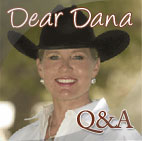Four more zones to ‘stops’
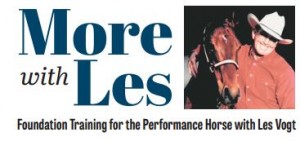 Last column, I introduced you to an entire stopping program that began with “whoa” and proceeded to the next phase, the “signal stop.”
Last column, I introduced you to an entire stopping program that began with “whoa” and proceeded to the next phase, the “signal stop.”
Random Stop
So, when he has learned the signal stop, we go into the next phase, which is going to be random stops. We take what he knows now, and we teach him that he is going to gallop or trot around the arena. As with the other steps, this one has to be in all of his gears or gaits as well. He has to graduate up to the gallop. Now, at this stage in the game, the walk probably is not going to count, but he has to master the trot and the gallop for sure, and he has to be perfect in both.
Did your horse ‘fire’ you?
“Bucking is used to establish a pecking order. The unwelcomed behaviors are the horses’ natural instinct to test your role as leader in the partnership …”
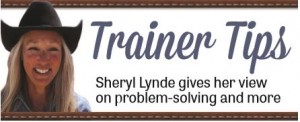 Are you noticing changes in your horse’s attitude when he is being handled or under saddle that is causing you to be concerned? Is he more attentive to pasture mates and other horses when out on the trail than he is on you? Do you feel “out-of-your-depth” when you try to safely identify and resolve the unwanted behaviors? Well, he could be challenging your position in the pecking order. It’s possible you have been fired!
Are you noticing changes in your horse’s attitude when he is being handled or under saddle that is causing you to be concerned? Is he more attentive to pasture mates and other horses when out on the trail than he is on you? Do you feel “out-of-your-depth” when you try to safely identify and resolve the unwanted behaviors? Well, he could be challenging your position in the pecking order. It’s possible you have been fired!
Smokey: A study of heart
 Smokey is a 3-year-old Quarter Horse gelding. The owner needed my help with some fear-related issues that Smokey had. Although he had been started, the owner had some concerns and didn’t feel comfortable riding him.
Smokey is a 3-year-old Quarter Horse gelding. The owner needed my help with some fear-related issues that Smokey had. Although he had been started, the owner had some concerns and didn’t feel comfortable riding him.
He had quality breeding that showed in his natural athleticism, but his moves were bigger than necessary and unpredictable. When he first arrived, I put him in the round pen just to let him get acclimated to his new surroundings. I stood in the distance and watched as he spooked at something, lost his footing and actually fell over — all by himself! The owner’s concerns were well-founded, and I had to get Smokey’s behavior corrected not only for the owner’s safety, but for Smokey’s well-being, too. Horses don’t want to live in fear any more than we do. They are looking for someone whom they can draw confidence from, someone to show them a better way to handle their emotions. If he didn’t get help with his fear at this juncture, then his reactions would have continued to escalate. He couldn’t resolve this on his own.
Seven Steps To Big Stops
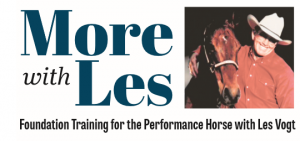 Now, I’m going to introduce you to the whole stopping program so you’ll know where we’re going with this. Although we’ll only cover the basics – the collected stop – in this level, this will give you an idea of where we’ll be headed as you advance in this program. We’ll call the stopping program the “Seven Steps to Big Stops.” The seven steps are sequential, and you have to pass each step, and get a good grade in each phase, or you can’t go on. I guess you could but you’re going to get an “F” in the next one. It will take time, but you will get it, and like everything else, you have to work at achieving perfect form at each step so that you can get perfect performance.
Now, I’m going to introduce you to the whole stopping program so you’ll know where we’re going with this. Although we’ll only cover the basics – the collected stop – in this level, this will give you an idea of where we’ll be headed as you advance in this program. We’ll call the stopping program the “Seven Steps to Big Stops.” The seven steps are sequential, and you have to pass each step, and get a good grade in each phase, or you can’t go on. I guess you could but you’re going to get an “F” in the next one. It will take time, but you will get it, and like everything else, you have to work at achieving perfect form at each step so that you can get perfect performance.
We might say that a horse stops well, but there is really so much more to it. Stopping means to cease forward motion, but the stop itself is really the least of my worries. First, the approach has to be good, the form has to be perfect, and there can be absolutely no resistance – if any of these elements aren’t great, the stop won’t be great either.
Removing trailer-loading anxiety
 A client once brought a horse to me that had developed trailer-loading issues. It had endured an accident while being tied inside a trailer, and she had pulled back, resulting in minor injuries both physically and mentally. Subsequently, the owner had difficulty getting her into the trailer, and even once in, she would want out — and fast. She could fly backward.
A client once brought a horse to me that had developed trailer-loading issues. It had endured an accident while being tied inside a trailer, and she had pulled back, resulting in minor injuries both physically and mentally. Subsequently, the owner had difficulty getting her into the trailer, and even once in, she would want out — and fast. She could fly backward.
If you break it down, there are a couple of issues here. In addition to her anxiety while in the trailer, she also had an issue with pulling back. I’ll tackle Issue No. 1 first, which is her overall anxiety while inside the trailer. If I were able to eliminate her anxiety and help her to feel more at ease in the trailer, she would be less likely to pull back.
To start, I removed a panel from my round pen and then backed my trailer up to the opening until it was flush with the other panels. While standing inside the round pen facing the trailer door, I opened the door of the trailer to my right until it swung flush to a panel, where I secured it. To the left of the trailer opening, I pulled that round-pen panel, so it was even with the trailer and secured it there, leaving no spaces or unsafe edges between the panels and the opening of the trailer. I left the truck hitched to the trailer to make sure it remained stable while the horse loads and unloads.
The Sequence Stop
More with Les - Foundation Training for the Performance Horse with Les Vogt
 Sequence stop means a three stepper basically. You’ll have three or four steps from the beginning to the end for the stop. If you’re having problems keeping your hands moving, try the sequence stop. Remember, if you like the neck, you’re going to back him out of the stop. If you don’t like the neck, you’re going to drive him forward again, so why would you stop moving your hands? And don’t worry about timing here; you’re just searching for flaws throughout those beats.
Sequence stop means a three stepper basically. You’ll have three or four steps from the beginning to the end for the stop. If you’re having problems keeping your hands moving, try the sequence stop. Remember, if you like the neck, you’re going to back him out of the stop. If you don’t like the neck, you’re going to drive him forward again, so why would you stop moving your hands? And don’t worry about timing here; you’re just searching for flaws throughout those beats.
To judge, or NOT to judge
 We are confronted with a multitude of distractions every day. It takes an ongoing awareness and effort to leave the world outside the arena in order to learn to focus on ourselves and our horse. Quieting your mind and letting go of distractions allows you to concentrate on your body and your horse’s movements. Attainment of any goal you set, whether it is mastering a specific maneuver or overcoming a habit you have judged as a bad one, depends on your mental game.
We are confronted with a multitude of distractions every day. It takes an ongoing awareness and effort to leave the world outside the arena in order to learn to focus on ourselves and our horse. Quieting your mind and letting go of distractions allows you to concentrate on your body and your horse’s movements. Attainment of any goal you set, whether it is mastering a specific maneuver or overcoming a habit you have judged as a bad one, depends on your mental game.
This takes an understanding of the “inner game” of your mind. It’s the first step that moves aside confusion and fear, replacing them with confidence regardless of the circumstances or surroundings. Being focused on each maneuver is just as instrumental to your training regime as the reins are to the bridle.
In the book “The Inner Game of Tennis,” author W. Timothy Gallway defines judging our efforts as a culprit that leads to trying too hard. For instance, when riders continually judge or place a negative value to a habit as “bad,” such as always leaning in turns, they will begin to identify themselves with the habit itself. They bring this identification to their riding lesson and their focus changes from being aware of what their body is doing to the mindset of what NOT to do.
Polishing collected stops
![]() As we discussed in my last column, your goal in a collected stop is to make going forward a lot of work for your horse. Make him really step up and put some effort into it.
As we discussed in my last column, your goal in a collected stop is to make going forward a lot of work for your horse. Make him really step up and put some effort into it.
To let him stop, we’re going to keep our hands moving while we stop driving him with our legs. The result you’re looking for is that he will stop with his back legs underneath him since his back is so round and his poll is soft. You’re not looking for a hard stop here, but for perfect form—neck soft, back round, hind end underneath.
Clinic case: break progress into steps
 During the three-day Norco Horse Affair last month, I gave a demonstration on Dude, a 9-year old Mustang that lacked confidence. His current owner has owned him for two years, and prior to that he had been owned by four others.
During the three-day Norco Horse Affair last month, I gave a demonstration on Dude, a 9-year old Mustang that lacked confidence. His current owner has owned him for two years, and prior to that he had been owned by four others.
Because of an injury to the current owner (unrelated to Dude), the horse had not been ridden, saddled, or even removed from the property for a year. Just entering his pen, he was apprehensive and reactive. Prior to her injury, the owner had been riding Dude with no issues under saddle other than the occasional crow-hopping. The biggest issue was saddling – she had never really been able to saddle him while quietly standing tied. She would lunge him, and if she managed to land the saddle on his back without him making a dash, that would be a successful session.
Making of a ‘Keeper’ takes time
 In preparation for my upcoming demonstrations at the Norco Horse Affair Oct. 6-8, I sent out a request for a fearful horse to use. Immediately, I received responses and videos. I selected the first one I received, but another horse that came in later reminded me of an 18-month-old colt that once was sent to me to start.
In preparation for my upcoming demonstrations at the Norco Horse Affair Oct. 6-8, I sent out a request for a fearful horse to use. Immediately, I received responses and videos. I selected the first one I received, but another horse that came in later reminded me of an 18-month-old colt that once was sent to me to start.
Starlight Sam I Am was his name, and he had a common link to the horse recently offered to me for my demo – they had a level of fear that would not be fixed in an hour’s time.
Sam’s fear was unpredictable and explosive. He was a danger to himself and anyone handling him. He lacked self-preservation, meaning if he put himself through a fence during one of his episodes — so be it. This wasn’t due to anything the owner had caused. Sam arrived with his baggage. An attempt to touch his hind legs would elicit a rapid-fire kick. One day he would accept the saddle, but the very next day while repeating the identical steps, he would flip over backward multiple times. As soon as he got to his feet, he would launch into a 20-minute bucking spree with me on the other end of the lead rope, trying to keep him contained in the round pen.


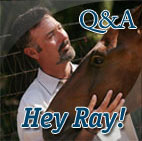
 Read Columns
Read Columns
